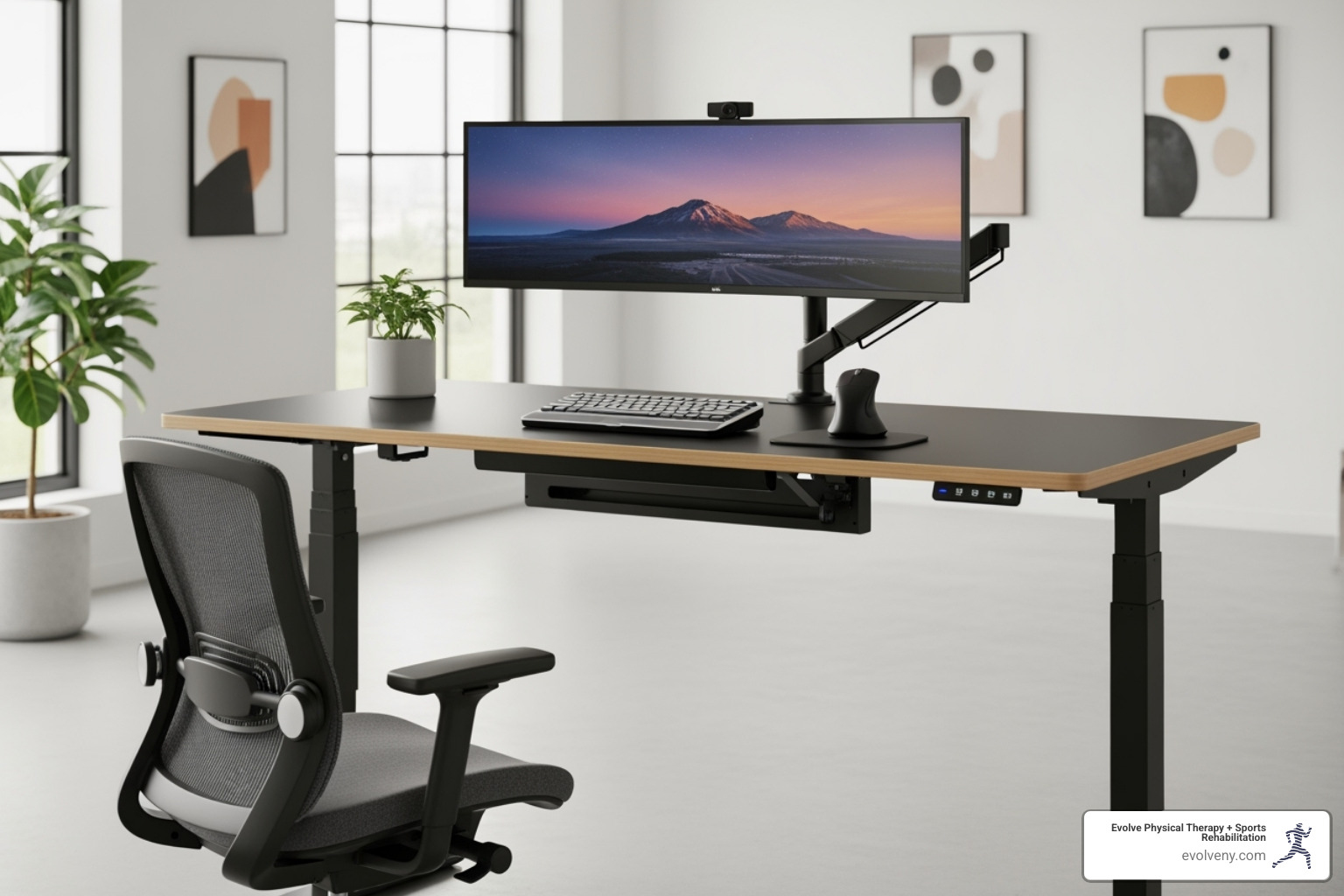Awkward Postures at Work? Here's Your Ergonomic Survival Guide
Why Your Body Is Screaming for Better Workplace Ergonomics

Awkward posture ergonomics is the science of designing work environments to minimize harmful body positions and reduce the risk of musculoskeletal disorders. Here's what you need to know:
- Neutral posture: The body is positioned with minimal strain.
- Awkward posture: Any deviation from neutral, like bending or twisting.
- Key risks: Muscle fatigue, reduced force, and compressed nerves.
- Prevention: Ergonomic tools, proper workstation design, and regular breaks.
- Assessment methods: REBA and OWAS evaluation systems.
If you've ever felt neck ache from hunching over a computer or back pain from lifting boxes, you've experienced the effects of awkward postures. These aren't minor inconveniences; they're warning signs of potential injury.
Statistics show that more than half of all workers have neck problems, 30% suffer from shoulder tension, and 26% experience wrist and arm pain. Awkward postures are a leading cause of sick leave and workplace absenteeism.
An "awkward" posture forces your body from its natural alignment, making muscles work harder and less efficiently. This leads to faster fatigue and stress on your joints, tendons, and nerves.
The path to chronic injury often starts with pain during work that vanishes with rest (Stage 1). It progresses to symptoms that persist after work, disrupting sleep (Stage 2), and can end in constant, debilitating pain that impacts your quality of life (Stage 3).
As the founder of Evolve Physical Therapy, I've seen how proper awkward posture ergonomics can prevent these injuries. My approach combines manual therapy with workplace modifications to address both symptoms and root causes.
Defining Awkward Postures vs. Neutral Alignment
Understanding the difference between neutral and awkward postures is the foundation of awkward posture ergonomics. It can mean the difference between ending your workday energized or exhausted.
What is a Neutral Posture?
Neutral posture is when your body parts are positioned at their natural, mid-range of motion with minimal strain. Your muscles are at their resting length, joints are aligned, and no conscious effort is needed to hold the position. In neutral alignment, your muscles work with maximum efficiency. Your proper alignment of the spine maintains its natural curves, distributing weight evenly and minimizing stress.
This is why good posture for office workers is so important. A workstation that supports a neutral position allows you to work longer with less fatigue because your muscles aren't fighting gravity or awkward angles.
What Makes a Posture "Awkward"?
Awkward postures are positions that force your body away from its neutral alignment. This includes bending, twisting, reaching far from your body, squatting for extended periods, or kneeling. When a joint is pushed toward the end of its range of motion, you've entered awkward territory.
In these positions, your muscles must work much harder, leading to inefficiency and exhaustion. Static postures—holding any position for too long—are also problematic. They cause muscle fatigue, decrease blood flow, and can lead to compressed nerves and tendons sending pain signals.
The result is increased exertion, faster fatigue, and discomfort. Unfortunately, many of us develop habits that lead to bad office posture without realizing it. Understanding these concepts is the first step toward creating a healthier work environment. Listening to your body's signals puts you in control of your long-term health.
The High Cost of Poor Posture: Health Risks and MSDs
That nagging neck pain or shoulder tension isn't just an annoyance; it's your body signaling that something needs to change.

Musculoskeletal disorders (MSDs), which affect muscles, bones, and nerves, are among the most common workplace injuries, with poor awkward posture ergonomics as a major cause. Over half of all workers deal with neck problems, 30% have shoulder tension, and 26% experience wrist and arm pain. The economic impact is also staggering, with awkward postures causing significant sick leave, lost productivity, and healthcare costs.
Continuous exposure to awkward postures can lead to fatigue failure in the spine, causing chronic pain. This is why we focus on treatments like physical therapy for back pain Brooklyn and physical therapy for neck pain Brooklyn. Research confirms that good posture is key to the reduction of musculoskeletal disorders.
Key Risk Factors for Injury
Understanding risk factors helps you take action before an injury occurs.
- Duration: The longer you hold an awkward position, the more strain it places on your tissues. Static postures are especially harmful as they restrict blood flow.
- Frequency: Repeating an awkward position, even briefly, creates cumulative trauma as your body doesn't have time to recover.
- Degree of deviation from neutral: The further you move from your body's natural alignment, the harder your muscles must work.
- Forceful exertions: Combining an awkward posture with lifting or pushing creates a perfect storm for injury, as muscles can't generate force efficiently.
- Static loading: Maintaining muscle contractions for long periods without relaxation leads to rapid fatigue.
- Repetitive motions: Performing the same motions in an awkward position can lead to overuse injuries like tendinitis.
The Three Stages of Musculoskeletal Injury
Most workplace injuries develop gradually through three stages. Recognizing them is key to preventing chronic disability.
- Stage 1: Pain and fatigue appear during work but disappear with rest. It's easy to dismiss these early warning signs, but your body is asking for attention.
- Stage 2: Symptoms persist after work, disturbing sleep and reducing your work capacity. The problem is getting worse.
- Stage 3: Pain becomes chronic and persistent, significantly impacting your quality of life and daily activities.
The progression through these stages in the development of injuries isn't inevitable. Intervention in Stage 1 or early Stage 2, through ergonomic changes and physical therapy for posture training, can prevent chronic pain. Listen to your body's early signals; pain is valuable information.
Proactive Prevention: Your Guide to Awkward Posture Ergonomics
Most health risks from poor posture are preventable. With the right approach to awkward posture ergonomics, you can transform your workspace and habits to protect your body. It's about working smarter, not harder, by redesigning how you work to support your body's natural alignment. Our approach to physical therapy for posture training emphasizes prevention alongside treatment.

The Hierarchy of Ergonomic Controls
Ergonomics experts use a hierarchy of controls to tackle awkward postures, prioritizing the most effective solutions first.
- Elimination: The most effective solution. Can you completely avoid the awkward posture, such as by storing items at waist height instead of on the floor?
- Substitution: If elimination isn't possible, swap out tools or change processes. Use a headset instead of cradling a phone.
- Engineering controls: Modify the physical environment with adjustable desks, ergonomic chairs, and monitor arms.
- Administrative controls: Change how work is done through job rotation, mandatory breaks, and training on proper body mechanics.
- Personal Protective Equipment (PPE): Items like knee pads can provide cushioning but don't eliminate the awkward posture. They are best used with higher-level controls.
Recommended Time Limits for Awkward Postures
Even with a good workspace, some awkward postures may be unavoidable. Knowing your limits is crucial. Prolonged exposure is what causes problems.
Research suggests limiting certain postures to about 2 hours total per shift. This includes:
- Neck bent more than 30 degrees
- Back bent more than 30 degrees
- Working with hands above your head or elbows above shoulders
- Kneeling
Squatting should be limited as much as possible due to the stress on the knees and back. These limits are based on research into tissue breakdown. The key is variety and movement. Take regular breaks, change positions, and listen to your body's signals.
Designing a Safer Workspace: Practical Ergonomic Solutions
Creating a workspace that supports your body's natural alignment is practical and simple with awkward posture ergonomics. Your workspace should adapt to you, not the other way around. This is crucial for both office settings and when dealing with home office ergonomics or achieving correct computer posture.
Common Awkward Postures and How to Fix Them
Let's tackle common positions that gradually wear down your body.
- Working overhead: This strains your neck and shoulders. The fix: Use step stools, ladders, or tool extenders to bring your body to the work.
- Bending forward: Compresses your spine and overworks back muscles. The fix: Raise the work surface using adjustable-height desks, lifting devices, or proper monitor positioning.
- Reaching and over-reaching: Creates cumulative strain. The fix: Rearrange your workspace to keep frequently used items within arm's length.
- Twisting your torso: Happens with poor workspace layout. The fix: Turn your whole body to face what you need. Ensure your chair swivels easily.
- Kneeling and squatting: Strains knees and back. The fix: Use comfortable knee pads, adjustable stools, or lifting aids.
- Forward head posture ("tech neck"): Caused by craning your neck toward screens. The fix: Bring screens to eye level. Hold handheld devices higher.
- Bent wrists: Caused by poor keyboard and mouse placement. The fix: Keep wrists straight and neutral, with forearms parallel to the floor, by adjusting your chair or using a keyboard tray.
If you're working from home and experiencing back pain, these adjustments can provide immediate relief.
Applying Awkward Posture Ergonomics to Tool Selection
Smart tool selection is a game-changer for maintaining neutral postures.
- Grip Type: Use a power grip (whole hand) for forceful tasks. Reserve pinch grips (thumb and fingers) for light, brief tasks.
- Handle Size and Shape: Handles should fit your hand comfortably. For power grips, a diameter between 1.75 and 3.75 inches is ideal. Contoured, textured handles are best.
- Tool Weight: Heavy tools cause fatigue up the entire arm. Choose lighter tools or those with dual-handle options to distribute weight.
- Adjustable Handles: Tools with adjustable handles (e.g., inline vs. pistol grip) help you maintain a neutral wrist position for different tasks.
- Force Reduction Features: Look for spring-loaded handles, ratcheting mechanisms, or counterbalances to reduce the effort you need to apply.
The goal is to apply effort efficiently, with your body in positions that support strength, not strain.
Taking Action: How to Identify, Assess, and Report Risks
Understanding awkward posture ergonomics is the first step; taking action is next. This requires a collaborative effort to identify, assess, and report ergonomic risks.
Understanding the Basics of Awkward Posture Ergonomics Assessment
Ergonomic assessments provide systematic ways to evaluate tasks and identify hazards.
- Observation: Watching how a job is performed can reveal repeated bending, twisting, or static positions.
- Employee Feedback: Workers are the best source of information on discomfort and strenuous tasks. Encourage them to report issues.
- Checklists: Standardized checklists help identify common risk factors.
- Formal Assessment Methods: For a scientific approach, tools like REBA (Rapid Entire Body Assessment) and OWAS (Ovako Working Analysis System) are used. REBA assesses specific postures to determine MSD risk, while OWAS evaluates a sample of postures over time to assess cumulative load.
These methods help quantify risks objectively, guiding effective solutions. The OSHA website offers resources on how to identify ergonomic problems.
Creating a Collaborative Safety Culture
Effective ergonomics requires a collaborative safety culture where everyone works together.
- Open Communication: Employees should feel empowered to report risks without fear of reprisal through clear reporting channels.
- Employee Training: Educating employees on proper body mechanics, neutral posture, and ergonomic benefits increases awareness and compliance.
- Management Commitment: Employers must commit resources for assessments, implement changes, and provide proper equipment.
- Joint Health and Safety Committees: Committees with both management and employee representatives can oversee ergonomics programs.
- Continuous Improvement: Ergonomics is an ongoing process. Regularly reassess, gather feedback, and adapt solutions for long-term success.
A collaborative spirit creates workplaces that reduce injuries and improve productivity and morale.
Frequently Asked Questions about Awkward Posture Ergonomics
Here are answers to common questions about awkward posture ergonomics based on my experience at Evolve Physical Therapy.
How do I know if my posture is awkward?
An awkward posture forces your joints away from their comfortable, neutral middle ground. Telltale signs include bending your neck, twisting your spine, hunching your shoulders, or reaching far from your body. The real test is to listen to your body. If you feel strain, fatigue, or nagging discomfort, your posture is likely awkward. If a position requires conscious effort or leaves you sore, it's time for a change.
Can stretching during breaks really help?
Yes, absolutely. When you hold static or awkward postures, muscles get tight and blood flow decreases. Frequent, short stretching breaks relieve muscle tension, restore circulation, and reduce fatigue. Even a few minutes of gentle stretching or walking around can reset your body, improve flexibility, and prevent the cumulative strain that leads to injury. Your body needs movement and variety.
Is a standing desk a good solution for awkward postures?
A standing desk can be a fantastic tool against the negative effects of prolonged sitting, but it's not a magic bullet. The key to awkward posture ergonomics is movement and variety, not just finding one "perfect" position. A standing desk is most effective when you maintain a neutral standing posture (ears over shoulders, shoulders over hips) and, most importantly, alternate between sitting and standing throughout the day. Trading eight hours of sitting for eight hours of standing just swaps one static posture for another.
Conclusion
After diving into awkward posture ergonomics, it's clear your body isn't meant to suffer through workdays in uncomfortable positions. The evidence is overwhelming, but the good news is that most of these injuries are preventable. Understanding neutral postures and recognizing early warning signs allows you to take meaningful action. Every ergonomic adjustment is an investment in your long-term health.
The stages of injury are not inevitable; they are warning signs. That afternoon neck ache is your body asking for help. The beauty of awkward posture ergonomics is that small changes—like adjusting your monitor, taking breaks, and using the right tools—yield big results.
At Evolve Physical Therapy + Sports Rehabilitation, our hands-on approach combines manual therapy with practical workplace modifications to address both symptoms and root causes. We help patients reclaim their active lifestyles by taking control of their environment.
Pain shouldn't be your daily companion. Taking a proactive approach to ergonomics can make all the difference. Your body is sending signals; it's time to listen.
Ready to transform how you feel? Find out how personalized ergonomic physical therapy Brooklyn services can help you achieve lasting comfort and peak performance.

